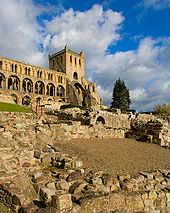Jedburgh
[5] Bishop Ecgred of Lindisfarne founded a church at Jedburgh in the 9th century, and King David I of Scotland made it a priory between 1118 and 1138, housing Augustinian monks from Beauvais in France.
[10] Its proximity to England made it subject to raids and skirmishes by both Scottish and English forces but its strategic position also brought the town valuable trade.
[11] Jedburgh was burnt in September 1523 by an English force commanded by William Bulmer and Thomas Tempest.
[13] During the war with England now known as the "Rough Wooing", the Scots and their French allies made plans to fortify Jedburgh in 1549, with the advice of Camillo Marini, an Italian military engineer.
[15] Mary fell ill, and on 25 October 1566, the Privy council issued a "Proclamation to keep good rule at Jedburgh" during the time of her recuperation.
[16] The title "Lord of Jedburgh Forest" was granted to George Douglas, 1st Earl of Angus on his marriage to the Princess Mary, daughter of Robert III in 1397.
[18] On 6 November 1745, the Jacobite army led by Prince Charles Edward Stuart passed through the town on its way to England.
[23] This was one of the findings that led him to develop his concept of an immensely long geologic time scale with "no vestige of a beginning, no prospect of an end.
Other places nearby are Ancrum, Bairnkine, Bonjedward, Camptown, Crailing, Edgerston, Ferniehirst Castle, Nisbet and Oxnam.
James Thomson (1700–1748) who wrote "Rule Britannia", was born in Ednam, a village only twelve miles away, but he was educated in Jedburgh.
[29] David Brewster, physicist, mathematician, scientist, writer and inventor of the kaleidoscope, was born in Jedburgh in 1781.
[40] Emmy Award-winning journalist Nick Watt is from Jedburgh and hosted a short film about the town for the Travel Channel.
[41] The abbey is maintained by Historic Environment Scotland and open to the public (there is an entry fee).
Finds from excavations are displayed on site in the visitor centre attached to the Abbey ruins.
The nearby Capon Oak Tree is recognised to be of national interest[47] and the 19th century Jedburgh Castle Jail[48] and Newgate, with its spire, are among the town's notable buildings.
[56] A 1930s club, punningly named Jed Arts, won the East of Scotland League[57] and the Border Cup[58] in 1936–37.





